VVAM Newsletter 68 – 1997
FRIENDS OF THE AIRBORNE MUSEUM
Editors:
Drs. R.P.G.A. Voskuil
C. van Roekel
G.H. Maassen jr.
Newsletter No. 68, November 1997
Translated by Cathrien and Peter Clark
Representative in Great Britain: Mr. E.E. Shaw, 298 Totnes Road Paignton – Devon TQ4 7HD Tel. 0803-S53616
Obituary: General Sir John Hackett
On 9 September 1997, a week or so before the 53rd commemoration of the Battle of Arnhem, General Sir John Hackett passed away at his country home in Cheltenham, Gloucestershire. Sir John was 86 years of age.

General John Hackett stands lost in thought between the graves after the service of remembrance at the Airborne Cemetery on Friday 77 September 1965.
(photo: Henk Vreman)
He commanded the 4th Parachute Brigade which landed on the Ginkelse Heide near Ede on 18 September 1944. Nearly a week later, on Sunday the 24th, he received serious shrapnel wounds to the stomach and legs. He was taken to St. Elisabeths Gasthuis in Arnhem where his life was saved by the British surgeon Lipmann Kessel. Hackett was registered as a corporal at the hospital, so the Germans never knew that such an important man lay within their grasp.
Ten days later he was ’transported’ to Ede by Piet Kruyff, one of Arnhem’s most important Resistance leaders who operated under the codename ‘Piet van Arnhem’.
In Ede he went into hiding in the house of the ladies De Nooij. Fie was given false Dutch identification papers bearing the name ‘Johan van Dalen’. Four months later, aided by the Resistance, he managed to reach the liberated part of the Netherlands via the Biesbosch.
After the war he held many high military posts, including that of commander of the British Army of the Rhine. He remained on active service until 1968. He recorded his experiences during and after the Battle of Arnhem in his 1977 book ‘I Was a Stranger’, the Dutch version of which, entitled ‘Ik ben een vreemdeling geweest’, appeared two years later.
The general was ‘leader of the (September) pilgrimage’ on many occasions, the last time being the 50th commemoration in 1994.
Sir John Hackett will be the subject of a Ministory some time in the future.
In Memoriam: Ken Greenough
One of our members, Ken Greenough, passed away on 19 October 1997 at the far too young age of 29. His death came at the end of a short illness with fatal complications. He was last in Oosterbeek in September this year for the commemoration. Ken, who lived in St. Helens near Liverpool, had been intensively involved with the history of the Battle of Arnhem for more than ten years, and his knowledge of the subject was encyclopedic. He corresponded with many veterans and had an extensive archive of personal stories and reports. This information was available to one and all, and any questions were always answered with the greatest of care.
He acted as a guide during the theme day on 7 June 1997. Participants will certainly remember his detailed explanation and unbounded enthusiasm.
It is difficult to imagine that Ken is no longer with us. He was buried in St. Helens, his home town, on 28 October. Among the many people who accompanied him on the journey to his final resting place were a delegation of Arnhem veterans and a number of his Dutch friends.
We shall miss Ken tremendously, and our thoughts are with Iris family at this tragic time.
(Robert Voskuil)
Theme day
The society is organising a theme day to be held on 13 December 1997 in the Lebret conference centre at Lebretweg 51 in Oosterbeek. This time the subject will be the German side of the Battle of Arnhem.
The programme is as follows:
1.30 pm – 2 pm: reception of the members.
2 pm – 3 pm: lecture by society member Mr Peter Berends from Leidschendam, entitled ‘The 9th SS Panzer Division “Hohenstaufen” and other German units during the Battle of Arnhem and shortly after, September-October 1944’.
Mr Berends has been studying the subject for a number of years and hopes eventually to round off this study with a book.
3 pm – 3.30 pm: intermission.
3.30 pm – 4 pm: the second part of Mr Berends lecture and the opportunity to ask questions.
4.15 pm – 4.30 pm: showing of the cinema newsreel ‘Die Deutsche Wochenschau’ (The German Newsweek), dating from 5 October 1944, which includes German film of the Battle of Arnhem.
4.45 pm (approx): end of the theme day.
John Frost’s hunting horn ‘found’ after 53 years
The Airborne Museum ‘Hartenstein’ was unexpectedly enriched on 16 September 1997 by a unique acquisition: John Frost’s original hunting horn, often used by him during the war to pass on orders and signals to his men of the 2nd Parachute Battalion.

Frost was given the 25 cm long copper horn with its silver mouthpiece by the hunt of which he was at Oosterbeek, 16 September 1997. Mr E.R. Oosterwijk from Meppel poses at the Airborne Museum ‘Hartenstein’ with John Frost’s hunting horn, found by him at the Rijnbrug in Arnhem in July 1945.
(photo: Berry de Reus)
member. It is engraved; ‘Capt. J.D. Frost, with best wishes from the members of the Royal Exodus Hunt’. When Frost, who had by then been promoted to Lieutenant-Colonel, was taken prisoner at the end of the battle at the Rijnbrug in Arnhem in September 1944, the musical instrument was taken from him by a German soldier. The hunt gave Frost a new horn after the war.
Now, 53 years after Frost’s original horn was ‘stolen’, it has resurfaced. It was offered to the Oosterbeek museum by Mr E.R. Oosterwijk from Meppel. Mr Oosterwijk found it in July 1945 close to the Arnhem road bridge. ‘I was there as a member of the Nijmegen air protection service, clearing rubble. I saw the hunting horn lying on the ground, completely blackened. I had it cleaned later’, says Mr Oosterwijk. The souvenir was taken home and stood for fifty years in a cabinet in his living room. The man from Meppel, now 76 years of age, decided it was high time that the instrument was given a new, good home. He was scarcely aware that he was in possession of a truly unique object.
On the advice of the local VW (tourist office), Mr Oosterwijk rang the Airborne Museum. There, the reaction of the staff was so enthusiastic that our prospective benefactor leapt aboard the first available train in order to take the hunting horn to Oosterbeek. John Frost’s widow has given the ‘Hartenstein’permission to include the horn in its collection. Needless to say the museum staff are absolutely delighted with this exceptional acquisition.
New commemorative envelope
A new Airborne Museum ’Hartenstein’ commemorative envelope made its appearance on 17 September 1997. It is the second in a series with ‘Monuments of the Battle of Arnhem’ as its theme. This envelope shows the Polish monument in Driel. The monument was designed by Jan Vlasblom from Rotterdam and was unveiled on 16 September 1961 by Major-General Stanislaw Sosabowski, commander of the 1st Polish Independent Parachute Brigade Group in 1944.
Two pillars were added in 1970 bearing the names of the 94 Polish servicemen who died during or as a result of the Battle of Arnhem.
750 numbered copies of the new envelope have been issued. The first 400 are franked with both 80 cent ’50 Years Marshall Aid’ commemorative stamps; the other 350 bear a single stamp. All were franked on 17 September 1997 with the philatelists stamp of the Oosterbeek Post Office.
As in previous years, envelope no. 001 was presented to the leader of the pilgrimage, this time Major- General A.J. Deane-Drummond.
The commemorative envelope with the two stamps costs 7 guilders, the example with one stamp, 6 guilders. They are available from the Airborne Museum.
Operation Market Garden on the Internet
The ‘Operation Market Garden’ website, set up by Andries Hoekstra from Arnhem, can now be found under http://www.pim.nl/mg/pegasus.htm. This shows the progress of the fighting in September 1944 with the Battle of Arnhem as the focal point.
The site also provides much more additional information. For instance, one can learn about the organisation of the Allied and German troops, their equipment, clothing and weapons. It also provides all manner of current information such as new publications on the subject, and one also has the opportunity to make comment.
At the moment the site consists of more than 300 pages and has been nominated one of the best in the world. Mr Hoekstra is supported by the Haarhuis Hotel in Arnhem and the Airborne Museum in Oosterbeek.
A look-back at the excursion
Fifty-eight people took part in the ‘battlefield tour’ of the former Arnhem and Oosterbeek battlefields, announced in the previous Newsletter.
After an explanation of the route in the Airborne Museum by the four guides, aided by the scale model of the battle area and photographs, the company left for a walk through the Hartenstein park. There then followed a visit to the former hotel ‘De Tafelberg’. Thanks to the kind co-operation of the present inhabitants the ’tourists’ were allowed to take a look inside the building.
After lunch at the Schoonoord restaurant a bus tour of the former battlefield was made. Dropping and landing zones ‘X’ and ‘S’ were visited in turn. A short walk was then made to the tunnel under the Utrecht/Arnhem railway line near Wolfheze where, on 17 September 1944, part of the Reconnaissance Squadron ran into an unexpected German defensive line.
Via the ‘hollow’ alongside the Valkenburglaan, the journey continued on to the John Frost Bridge, the St. Elisabeths Gasthuis and Zwarteweg in Arnhem. The tour ended at the Airborne Cemetery in Oosterbeek. Guides gave explanations at all points with the aid of maps and aerial photos.
Next year it is planned to make one or more similar general excursions for members or other interested parties.
(W. Boersma)

The Rev. R.F. Bowers and an acquaintance enjoy a small glass of Dutch gin together during the parachute drop on the Ginkelse Heide on 20 September 1997.
(photo: Berry de Reus)
‘Off at last’
‘Off at Last’ is the title of the new book about the 7th (Galloway) Battalion The King’s Own Scottish Borderers (7 KOSB), written by society member Robert Sigmond from Renkum.
The battalion was raised in 1939 and was used for coastal defence in Britain during the first years of the war until becoming ‘airborne’ in 1943. Together with the 2nd Battalion The South Staffordshire Regiment and the 1st Battalion The Border Regiment, it became part of the 1st Airlanding Brigade.
The battalion took part in the Battle of Arnhem in September 1944. Some 760 men under the command of Lt. Col. Robert Payton Reid left England by glider on 17 and 18 September 1944. Only 74 of them came back over the Rhine on the night of 25/26 September, eventually reaching Nijmegen. One hundred and twenty men of 7 KOSB lost their lives as a result of the Battle of Arnhem.
This nine-day period forms the main part of the book, although attention is also given to the Pegasus I and II escapes as well as to the prisoners-of-war. The battalion was re-constituted in 1945 and remained for a time in Norway as part of a liberation force. A chapter is also dedicated to this period.
The making of the 1945 film ‘Theirs is the Glory’ is given some attention as well, because a number of battalion members took part in the film.
Robert Sigmond has been studying the history of 7 KOSB since 1983 and has worked for three years on the production of ‘Off at Last’. More than 60 veterans made contributions in the form of personal accounts, documents and photos. Instead of (topographical) maps, the book contains aerial photographs taken at the time of the battle upon which the troop positions are indicated.
This book could be regarded as a sort of follow up to ‘When Dragons Flew, An Illustrated History of the 1st Battalion The Border Regiment 1939-1945’, published in 1994. The third part of what could be called a series on the 1st Airlanding Brigade is being worked on at the moment, the subject being the 2nd Battalion The South Staffordshire Regiment. 1.250 copies of ‘Off at Last’ have been produced and it is written in English. This beautifully prepared publication consists of 224 pages with 298 illustrations, and has a dust jacket in colour. The ISBN number is 90-9010449, it costs 57.50 guilders and is available from the Airborne Museum ‘Hartenstein’ and the Oosterbeek bookshops.
‘Off at Last’ can also be obtained by post by sending a cheque for 24 pounds (includes 4 pounds p&p. Write your name and address on the back of the cheque) or a Eurocheque for 24 pounds (also giving your name and address) to R.N. Sigmond, Utrechtseweg 126-A, 6871 DV Renkum, The Netherlands.
Further information can be provided by the author by ringing 0317 313533.
Reunion in Fallingbostel
A reunion was held at the former German prisoner- of-war camp Stalag XI-B in Fallingbostel during the weekend of 11 and 12 October 1997. Former prisoners-of-war and camp liberators were invited to the reunion on the initiative of L/Cpl Andy Hone of the British Tank Transporter Regiment, stationed there at the moment. Of the total of 14 veterans present, nine had fought in the Battle of Arnhem. It was a busy and interesting gathering. High points were a lecture by the local historian Hinrich Baumann, a walk along the site of the former camp, a memorial service at the Becklingen War Cemetery and a visit to the Tank Regiment Museum with its collection of excavated objects.
Compared to the original number of allied soldiers

Saturday 20 September 1997. Vehicles of the ‘Airborne Battle Wheels Oosterbeek’ association drive in convoy along Telefoonweg, taking them across the middle of former landing zone ‘X’. The journey ended at the Airborne Museum.
(photo: Berry de Reus)
involved, the number of participants at the reunion was relatively small. Later on it seemed this became the reason why close friendships were formed between people who did not know one another at all or had not seen one another since April 1945.
Thanks to the help of Stan Brooks (C Company, 2nd Parachute Battalion) I too was allowed to attend this reunion.
(Marcel Anker)
German Renault tanks in Oosterbeek
During a theme day in October 1992, society member Geert Maassen gave a lecture on the deployment of French Renault tanks by the Germans during the fighting in Oosterbeek in September 1944.
This talk prompted Philip Reinders of the ‘Arnhem Battle Research Group’ to delve deeper into the subject.
The results of Philip’s delving have now been put together in a brochure, published by himself, entitled ‘Panzer Kompagnie 224, De Char B2 in Nederland 1943-1945′. Besides a summary of this German company’s activities, the 40 pages also contain photographs of almost all the tanks that were put out of action in Oosterbeek as well as photos from the period before and after Arnhem’. The publication can be ordered by writing to Philip Reinders, Delftseveerweg 37d, 3134 JG Vlaardingen, The Netherlands, or telephoning/faxing 010 4356704.
Message from your UK representative
Thank you for your support of the Friends and for your generosity.
A kindly reminder that subscriptions are due on the 1st of January 1998. Donations are always welcome.
Signed
Ted Shaw, UK representative.

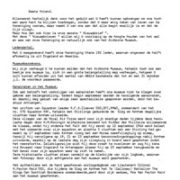
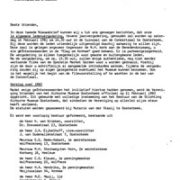
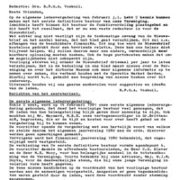
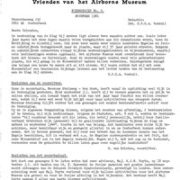
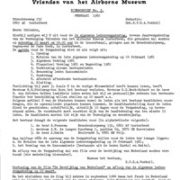
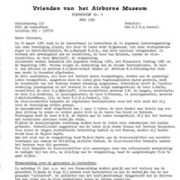
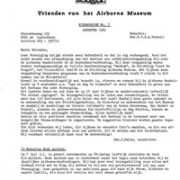
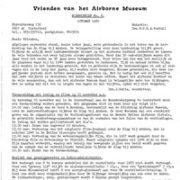
Plaats een Reactie
Vraag of reactie?Laat hier uw reactie achter.